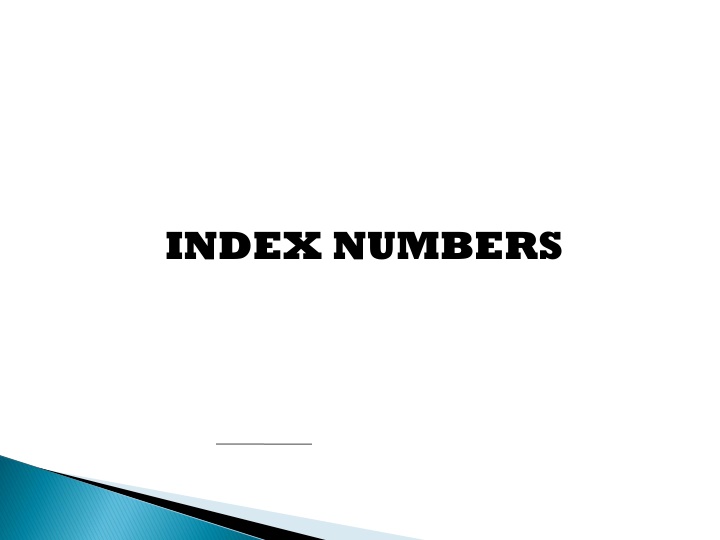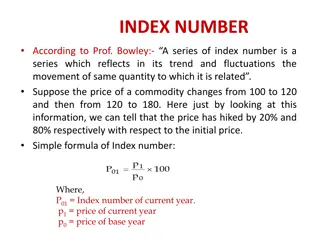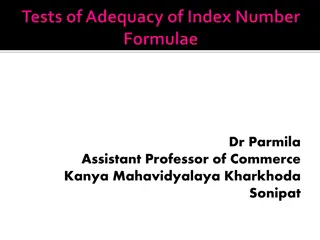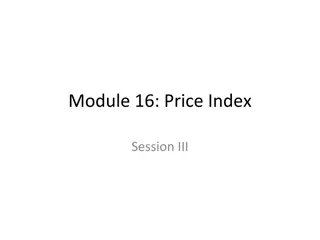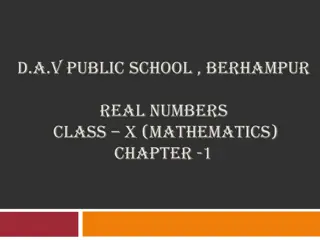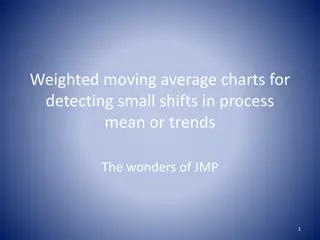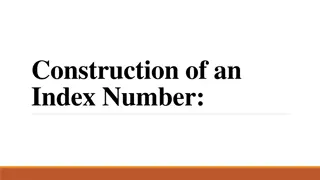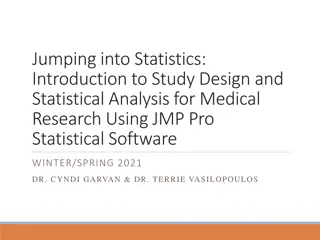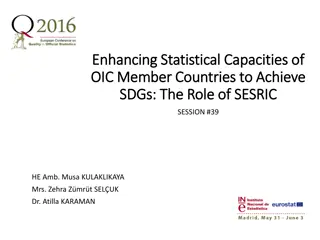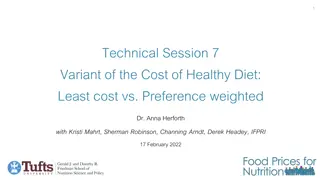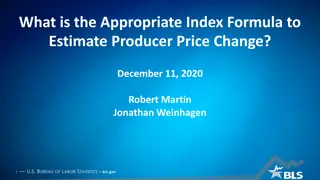Weighted Index Numbers in Statistical Analysis
Weighted index numbers play a crucial role in statistical analysis by assigning rational weights to items or commodities. These weights indicate the relative importance of each item in the calculation of an index. The construction of weighted index numbers involves methods such as the weighted aggregative method, Laspeyre's method, Paasche's method, Fisher's ideal method, and weighted average of price relatives method. Additionally, the concept of consumer price index (CPI) is explained, reflecting the average increase in the cost of commodities consumed by a specific group of people to maintain their standard of living. Methods of constructing CPI, like the aggregate expenditure method, are detailed along with steps involved in constructing consumer price index.
Download Presentation

Please find below an Image/Link to download the presentation.
The content on the website is provided AS IS for your information and personal use only. It may not be sold, licensed, or shared on other websites without obtaining consent from the author.If you encounter any issues during the download, it is possible that the publisher has removed the file from their server.
You are allowed to download the files provided on this website for personal or commercial use, subject to the condition that they are used lawfully. All files are the property of their respective owners.
The content on the website is provided AS IS for your information and personal use only. It may not be sold, licensed, or shared on other websites without obtaining consent from the author.
E N D
Presentation Transcript
Weighted Index numbers: While constructing weighted index numbers, rational weights are assigned to all item or commodities in an explicit manner. Such weights indicate the relative importance of items or commodities included in the calculation of an index. It can be constructed by two methods: Weighted aggregative method: Under this method, weights are assigned to various items and instead of finding the simple aggregate to prices, the weighted aggregate of the prices are obtained. Some of the important methods of constructing weighted aggregative indices are: Laspeyre s method: . P01 = P1q0 x 100 P0q0
Index Number: It is a statistical device for measuring changes in the magnitude of a group of related variables. Features or characteristics of Index Number: Index numbers are specialised averages. They are expressed in percentages. They measure the effect of changes in relation to time or place. They measure the changes not capable of direct measurement.
Paasches method: P01 = P1q1 x 100 P0q1 Fisher s ideal method: P01 = P0q0 x P0q1 Weighted average of price relatives method: In this method, the price relatives for the current year are calculated on the basis of the base year prices. These prices relatives are multiplied by the respective weights of the items. These products are added up and divided up by the sum of weights. P01 = RW W P1q0 x P1q1 x100
Consumer price Index(CPI): It reflects the average increase in the cost of the commodities consumed by a class of people so that they can maintain the same standard of living in the current year as in the base year. Construction of consumer price Index: The steps involved in construction of consumer price index are: Determining the scope and coverage of the Index: The first step is to decide the particular class of people, for whom the index numbers is intended. Family budget enquiry: The next step is to conduct a family budget enquiry by an randomly selecting a sample of adequate number of representative families from the class of people, for whom the index is designed. Obtaining price quotations: The third and the last step is to collect retail prices.
Methods of constructing CPI: The consumer price index numbers are constructed by the following two methods: Aggregate expenditure method or weighted aggregate method: To apply this method, the quantities of commodities consumed by the particular group in the base year are estimated and these figures are used as weights. Then, the total expenditure on each commodity for each year(base and current) are calculated. CPI = P1q0 x 100 P0q0
Family budget method or Method of weighted average of price relatives: In this method, the family budgets of a large number of people, for whom the index is meant, are carefully studied. Then, the aggregate expenditure of an average family on various commodities is estimated. These values constitute the weights. CPI = RW W
Uses of consumer price index(CPI) number: The importance of the consumer price index can be seen from the following points: It helps in wage negotiations, formulation of wage policy, price policy, rent control, taxation and general economic policy formulation. The government and business units uses it to regulate the dearness allowance or grant of bonus to the employees in order to compensate them for increased cost of living due to price rise. It uses to measure purchasing power of the consumer in rupees. It helps to identify the change in real wages. It is also used for analysing markets for particular kinds of goods and services.
Index of industrial production: The index number of industrial production measures changes in the level of industrial production comprising many industries. Index number of industrial production = [P1/P0 x 100]W W Uses of index numbers: Helps in policy formulation. Index numbers acts as economic barometers. Helps in studying trends. To measure and compare changes. Index numbers help to measure purchasing power. Index numbers help in deflating various values.
Limitations of Index Numbers: Provides relative changes only. Lack of perfect accuracy. Difference between purpose and method of construction. Ignores qualitative changes. Manipulations are possible.
Wholesale price Index number: They are those price index numbers which measure the general changes in the wholesale prices of goods in a country. Utility of wholesale price index number: Indicator of inflation. Forecasting demand and supply. Helps in determining real changes in aggregates. Useful in cost evaluation of various projects.
